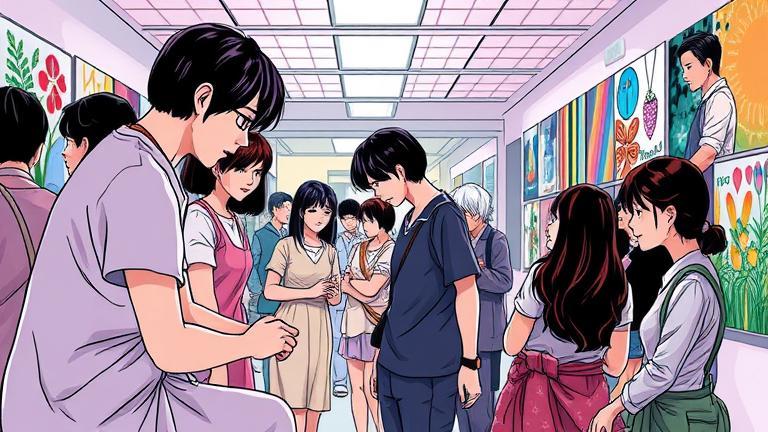On the cusp of the festival at the hospital art space, Clara kept her ear tuned to the pulse of creativity swirling around her. Raina’s vision of inviting the broader community to engage sparked a wildfire of inspiration among the team. ‘Let’s create spaces where everyone feels they belong, especially those often overlooked,’ Clara insisted, making her resolve known.
As the teams collaborated, Jenny proposed a ‘Living Canvas’ installation which would allow patients to actively paint their emotional journey throughout the duration of ‘Emotion Days.’ Raina leaped on that, saying, ‘Imagine if families painted alongside their loved ones — transforming their healing journeys into visual stories on canvas!’ Ben was quick to pull out his sketchbook to map out ideas on how to make it interactive, conceptualizing large panels on which visitors can individually express moments of vulnerability.
Meanwhile, Lena had come into her own throughout this journey. As festival day drew closer, Clara often found her either painting in silence or leading discussions about emotional representation in art. One day, Clara walked up beside her, fascinated by the mural that was developing on the studio wall. ‘What inspired this piece?’ she asked, admiring the mixture of deep blues with surprising bursts of vibrant yellows. Lena replied thoughtfully, ‘It’s about conflict and resolution. It reflects how light finds a way in even in the darkest of times.’
Inspired by Lena and each other, Clara decided to foster a few workshops even before the festival kicked off — creating preliminary artistic expressions that could set a precedent for emotional portrayal. ‘These sessions will be the heart of ‘Emotion Days,’’ she assured the group in a vibrant meeting hall that had never seen such enthusiasm.
As festival day arrived, excitement electrified the atmosphere. The main art space was alight with energy as families and individuals gathered, some emperors of grief, others joy, yet all beautiful in their authenticity. When Clara welcomed guests while draped in the eclectic, paint-smeared apron, it felt like the festival was not merely an occasion but rather the beginning of a new legacy.
As Ari played soft melodies, the attendees were guided to canvases around the room where they would express whatever emotional journey surfaced. Raina floated through the crowd, her encouraging spirit lifting those who looked uncertain. Suddenly, Oliver stepped forward with a passionate confidence that dazzled everyone; his artwork, he explained, represented silence screaming into a sea of vibrant colors, tearing through isolation. The resonance of empathy swept through the room like a gentle wave.
Towards the end, faces filled with catharsis mingled amidst laughter and shared tears. Clara approached one family who was painting together, each stroke echoing laughter as they lifted their hearts through vivid strokes of color. ‘What do you think is the biggest takeaway from this experience?’ Clara asked, curiosity lighting up her eyes. ‘To realize we’re not alone, that sadness feels intimate yet collective,’ the mother replied, wiping a tear but smiling through it.
As she wrapped up the segment, Dr. Carver stepped away from the crowds to join Clara’s side. He expressed admiration for how the community came alive through the collective storytelling via art. ‘What if we traveled beyond these walls? These emotions deserve to echo in galleries, not just here,’ he added. Clara felt pride burgeon inside her — her heart racing at the idea of their work reaching beyond hospital walls.
Months rolled on as ‘Emotion Days’ set its roots deep within the community. Each month’s exhibition became a beacon of cultural meetings where emotions wove itself more tightly to each story. Neighborhood banter filled the once sterile halls, where laughter and healing emerged as bright murals transformed through collective hands. ‘Healing,’ Clara realized, ‘has a way of twisting fear into threads of courage through art.’
Regular interactions between patients, their families, and artists led to something profound; they became stewards of one another’s emotional wellbeing while crafting lasting friendships. At one gathering, Clara unveiled plans for ‘Art and Healing Workshops’ to pilot emotional resilience frameworks paired with astute artistic expressions.
In the golden hour of each session, patients’ shields melted into visible vulnerabilities; every brushstroke entwining their identities. Lesions mapped resilience, like a recount of logbooks shared by a crew stitched by shared storms.
In a particularly moving moment, Lena gifted Clara one of her paintings: a powerful explosion of colors erupting from a dark void — it was struggle and triumph conjugated in delicate chaos. Clara savored the moment, emotions fluttering, proud to have orchestrated the renaissance of artistic therapy through honest emotional expressions at the hospital, marking a journey from isolation into blinding bloom.
Thus began a new identity for the hospital; not only a center of healing but a vibrant resonator of art bridged in love — where the raw exchanges painted hope and realization that every pulse, whether joyful or sorrowful, was equally beautiful.
